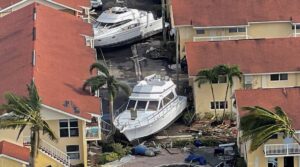Ian. A hurricane of lies.
Wed 12:58 pm +01:00, 12 Oct 2022Thus motivated to root out the source of the lies, I followed every data source I had. Data buoys,
Ventusky.com, and aviation weather reports. As Ian trudged its way into range of those data sensors,
not a single one showed wind speeds above 74 mph, entry-level of hurricanedom.
Most were 30 to 50
mph with gusts to as much as 60 to 80 or so. And these are all surface-level sources, the ones that
actually count. I knew as the bobble heads were crowing about Ian becoming a Category 5 storm (157
mph sustained for at least one minute, so gusts don’t count) it was eye-roll time. But I wanted to know
if the wind speed we were told was a dropsonde reading at some higher and irrelevant altitude, or if
they were just making it up. I needed to decode the dropsonde data.
As Ian passed over Florida and my friends and relatives reported little or no damage in spite of the
bobble heads’ screeches of “catastrophic!” and our own area seeing only about 40 mph winds, I got to
googlin’ the decoder again, and found it. Copy the raw data, paste it in the text box, and go. Bada-bing,
it was like finding the Rosetta Stone. The one data set I tested was taken near the eye wall when Ian as
in the Gulf, and the maximum wind it found was 135 mph at a pressure of 928 mb. Pressure goes down
as altitude goes up, and on average the pressure at the surface is about 1013 mb, going down with
altitude at a predictable rate depending on the stability of the air.
Converting 928 mb into an altitude
above ground level was a math exercise I won’t bore you with, but it’s roughly 2,000 feet up. I really
expected it to be higher, maybe 10,000 feet, but my hypothesis was correct that the maximum wind was
indeed not at the surface, or even ten meters. The final dropsonde reading before it plunged into the
churning sea to become ocean trash was a decidedly non-catastrophic 77mph. Barely hurricane force.
Stick your hand out the window as you drive down the highway, there’s Ian’s surface winds when he
was out to sea with no friction from land, trees, buildings and so on to slow it down. That’s not to
downplay 77 mph winds, as it will prune your trees and crumple up your badly made porch awnings.
Buildings in Florida are designed to withstand wind speeds of 130 to 150 mph, so modern buildings that
meet code will barely feel 77 mph winds.
http://mileswmathis.com/hurhoax.pdf

two undamaged boats nestle neatly between several undamaged houses.










